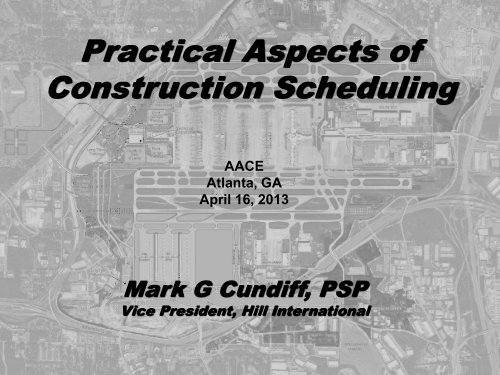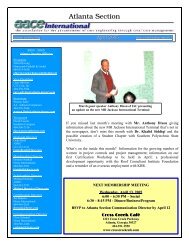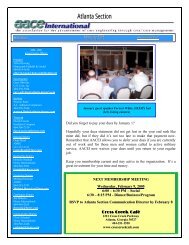Practical Aspects of Construction Scheduling - Atlanta Area Section
Practical Aspects of Construction Scheduling - Atlanta Area Section
Practical Aspects of Construction Scheduling - Atlanta Area Section
You also want an ePaper? Increase the reach of your titles
YUMPU automatically turns print PDFs into web optimized ePapers that Google loves.
<strong>Practical</strong> <strong>Aspects</strong> <strong>of</strong><br />
<strong>Construction</strong> <strong>Scheduling</strong><br />
AACE<br />
<strong>Atlanta</strong>, GA<br />
April 16, 2013<br />
Mark G Cundiff, PSP<br />
Vice President, Hill International
The Preparation <strong>of</strong> the Estimate involves planning and<br />
consideration <strong>of</strong> the construction sequence including:<br />
Means and Methods<br />
– Process Methodology & Equipment<br />
– Crewing<br />
– Duration, Sequence and Timing<br />
The Budget<br />
Components <strong>of</strong> a Project<br />
– Enterprise & Work Breakdown Structure<br />
– Productivity and Rate <strong>of</strong> Production<br />
– Direct Cost by CSI Division<br />
– Indirect Cost / Field Office, Plant and Overhead<br />
– Pr<strong>of</strong>it<br />
Schedule
Components <strong>of</strong> a Project<br />
Schedule<br />
The process <strong>of</strong> “Buying Out” the Project Estimate<br />
and establishing the Project Budget involves<br />
adjustments to the original concepts <strong>of</strong> planning<br />
and execution that are embodied within the Project<br />
Estimate.<br />
Details contained in the estimate and subsequent<br />
adjustments should be memorialized and clearly<br />
communicated to those responsible for scheduling<br />
and executing the project.
Components <strong>of</strong> a Project<br />
Schedule<br />
Formulating the Schedule<br />
Thus, the starting point for the Project Baseline<br />
Schedule originates from the project budget,<br />
contract, plans and specifications.<br />
The contract documents not only define work<br />
scope, they prescribe the responsibilities and<br />
hierarchy <strong>of</strong> the primary Stakeholders, Suppliers,<br />
Contractors, Subs and Lower Tier Subcontractors<br />
and their respective working relationships.<br />
4
Components <strong>of</strong> a Project<br />
Schedule<br />
The components <strong>of</strong> the Baseline<br />
Project Schedule include:<br />
• The Work Breakdown Structure<br />
• Work Activity Production Rate and Duration<br />
• “Hard” Logic Relationships driven by physical &<br />
resource linkage<br />
• Definition & Identification <strong>of</strong> <strong>Area</strong>, Level and<br />
Location within Activity IDs & Coding<br />
• Selection <strong>of</strong> Preferential Sequence “S<strong>of</strong>t Logic”<br />
by <strong>Area</strong>, Level & Location<br />
5
Components <strong>of</strong> a Project<br />
Schedule<br />
• Definition <strong>of</strong> the “Weather” Calendar<br />
• Identification <strong>of</strong> Key Milestones<br />
• Establishing Design, Procurement and Delivery<br />
Activities Leading into Work Activity Startup<br />
• Tabulating and Loading the Schedule with<br />
Quantity/Unit, Cost, Crewing/Manpower and<br />
Equipment Resources<br />
• The Process and Timing for Updating and<br />
Adjusting the Schedule<br />
6
Goals <strong>of</strong> <strong>Construction</strong><br />
<strong>Scheduling</strong><br />
To create a “model” <strong>of</strong> the “Project” embodying scope,<br />
defining duration and establishing the optimal sequence<br />
and timing <strong>of</strong> the works to completion in order to:<br />
• Progress Design and Work Activity on Time and Within<br />
Budget<br />
• Identify and Optimally Manage Risk<br />
• Minimize Time and Cost / Maximize Efficiency<br />
• Minimize the Impact and Consequence <strong>of</strong> Change<br />
• Maximize Pr<strong>of</strong>it<br />
7
Goals <strong>of</strong> <strong>Construction</strong><br />
<strong>Scheduling</strong><br />
To accomplish these goals, the<br />
Stakeholders must first decide on the<br />
primary type <strong>of</strong> schedule that best fits the<br />
characteristics and needs <strong>of</strong> the project.<br />
It should be noted that more than one<br />
scheduling methodology may be utilized to<br />
plan and execute a given project.<br />
8
<strong>Practical</strong> <strong>Aspects</strong> <strong>of</strong> <strong>Construction</strong><br />
<strong>Scheduling</strong><br />
It is not unusual that the various<br />
stakeholders involved in a project will own<br />
and utilize scheduling s<strong>of</strong>tware other than<br />
that specified and/or owned by those<br />
responsible for generating the schedule.<br />
Given the cost <strong>of</strong> commercial s<strong>of</strong>tware and<br />
familiarity with usage, there is <strong>of</strong>ten a<br />
tendency by many schedulers to “make<br />
do” with the s<strong>of</strong>tware they possess.<br />
9
<strong>Practical</strong> <strong>Aspects</strong> <strong>of</strong> <strong>Construction</strong><br />
<strong>Scheduling</strong><br />
While data can typically be transferred<br />
between scheduling s<strong>of</strong>tware packages,<br />
the “exact same” project schedule may<br />
produce different results when scheduled<br />
in different s<strong>of</strong>tware.<br />
Variances generated in the forward and<br />
backward pass using different s<strong>of</strong>tware is<br />
generally due to limitations in the s<strong>of</strong>tware<br />
and differences in algorithms between the<br />
respective programs.<br />
10
<strong>Practical</strong> <strong>Aspects</strong> <strong>of</strong> <strong>Construction</strong><br />
<strong>Scheduling</strong><br />
While it is possible to identify and “deal with”<br />
these variances, there is an element <strong>of</strong> risk<br />
involved which should be recognized and<br />
thoroughly considered before the use <strong>of</strong><br />
s<strong>of</strong>tware other than that specified and/or<br />
directed by the CM’s/GC’s contract is directly<br />
or tacitly accepted.<br />
11
Common Types <strong>of</strong> Prospective<br />
Schedules<br />
• Bar Chart Schedule (Gantt Charts)<br />
• Critical Path Method (CPM)<br />
Schedules<br />
• Line <strong>of</strong> Balance / Linear Schedules<br />
12
Bar Chart Schedule (Gantt Chart)<br />
13
Bar Chart Schedule (Gantt Chart)<br />
From Wikipedia; A Gantt chart is a type <strong>of</strong> bar chart, developed by Henry Gantt in<br />
the 1910s, that illustrates a project schedule. Gantt charts illustrate the start and<br />
finish dates <strong>of</strong> the terminal elements and summary elements <strong>of</strong> a project. Terminal<br />
elements and summary elements comprise the work breakdown structure <strong>of</strong> the<br />
project. Some Gantt charts also show the dependency (i.e. precedence network)<br />
relationships between activities. Gantt charts can be used to show current schedule<br />
status using percent-complete shadings and a vertical "TODAY" line as shown here.<br />
Although now regarded as a common charting technique, Gantt charts were<br />
considered revolutionary when first introduced. In recognition <strong>of</strong> Henry Gantt's<br />
contributions, the Henry Laurence Gantt Medal is awarded for distinguished<br />
achievement in management and in community service. This chart is also used in<br />
information technology to represent data that has been collected.<br />
14
Bar Chart Schedule (Gantt Chart)<br />
Strengths<br />
• Familiarity, The Most Common Schedule<br />
• Uses “Common Sense” Logic<br />
• Quick Determination <strong>of</strong> Gross Progress<br />
• Simplicity<br />
Henry Gantt
Bar Chart Schedule (Gantt Chart)<br />
Weaknesses include:<br />
• Limitations to level <strong>of</strong> scope & definition<br />
• Severe limitation to logic which can be shown<br />
• Difficult to determine project status<br />
• Does not address relative sensitivity/flexibility<br />
• Doesn’t contain sufficient detail for planning and<br />
executing complex work activity<br />
• The Critical Path is not defined
Critical Path Method Schedule (CPM)<br />
17
Critical Path Method Schedule (CPM)<br />
From Wikipedia, the free encyclopedia<br />
The essential technique for using CPM is to construct a<br />
model <strong>of</strong> the project that includes the following:<br />
A list <strong>of</strong> all activities required to complete the project<br />
(typically categorized within a work breakdown<br />
structure), The time (duration) that each activity will take<br />
to completion, and the dependencies between the<br />
activities<br />
Using these values, CPM calculates the longest path <strong>of</strong><br />
planned activities to the end <strong>of</strong> the project, and the<br />
earliest and latest that each activity can start and finish<br />
without making the project longer.
Critical Path Method Schedule (CPM)<br />
From Wikipedia, the free encyclopedia<br />
This process determines which activities are "critical"<br />
(i.e., on the longest path) and which have "total float"<br />
(i.e., can be delayed without making the project longer).<br />
In project management, a critical path is the sequence <strong>of</strong><br />
project network activities which add up to the longest<br />
overall duration. This determines the shortest time<br />
possible to complete the project.
Critical Path Method Schedule (CPM)<br />
From Wikipedia, the free encyclopedia<br />
Any delay <strong>of</strong> an activity on the critical path directly<br />
impacts the planned project completion date (i.e. there is<br />
no float on the critical path).<br />
A project can have several, parallel, near critical paths.<br />
An additional parallel path through the network with the<br />
total durations shorter than the critical path is called a<br />
sub-critical or non-critical path.
What is CPM <strong>Scheduling</strong>?<br />
• Critical Path Method<br />
– the longest chain <strong>of</strong> sequential activities to<br />
complete the project<br />
• Planned activities in a logical order with defined<br />
duration based on quantity, crew and production<br />
• A sequential network <strong>of</strong> appropriate proper<br />
relationships<br />
• A tool to identify and monitor progress against<br />
the baseline
Critical Path Method Schedule (CPM)<br />
Strengths<br />
• Time Scaled Logic / Logical Graphic Display<br />
allows for grouping by WBS and/or Codes<br />
• Facilitates Alternative Planning<br />
• Displays Critical and Near Critical Path(s)<br />
• Allows Sorting and Graphic Portrayal <strong>of</strong> Key<br />
Data<br />
• Quick Summary and Milestone Plots<br />
• Relative Ease <strong>of</strong> Resource & Cost Loading<br />
22
Critical Path Method Schedule (CPM)<br />
Weaknesses<br />
• Computer S<strong>of</strong>tware is essentially mandatory<br />
• Personnel resources are required for data entry<br />
• Must be monitored, maintained and updated<br />
• Is subject to manipulation by numerous methods<br />
• Algorithms for resource leveling, etc. are typically<br />
built into the s<strong>of</strong>tware and are not disclosed<br />
• Menu driven format “limits” flexibility<br />
23
Critical Path Method Schedule (CPM)<br />
Weaknesses<br />
• CPM does not readily discern nor identify the distinction<br />
between “hard” logic links and “s<strong>of</strong>t” logic links. S<strong>of</strong>t logic<br />
can be used to distort and/or hide available flexibility (float)<br />
within the construction program<br />
• CPM does not readily graphically portray potential “conflict”<br />
between trade crews, work area & locations within the<br />
construction sequence.<br />
• With CPM there are many ways to write the logic <strong>of</strong> the project,<br />
and unfortunately can prove to be self-serving for whoever<br />
creates the schedule.<br />
24
Common <strong>Scheduling</strong> S<strong>of</strong>tware<br />
Common <strong>Scheduling</strong> S<strong>of</strong>tware include<br />
– Primavera P6 and earlier version P 3.1<br />
– SureTrack<br />
– MS Project<br />
– Safran<br />
– Asta <strong>Scheduling</strong><br />
– Spider Project<br />
– Tilos<br />
– Vico
Common Display <strong>of</strong> a CPM Schedule<br />
26
Time Scaled Logic Diagram Example<br />
Example <strong>of</strong> a Time Scaled Logic Diagram<br />
27
Line <strong>of</strong> Balance/ Linear <strong>Scheduling</strong><br />
Linear <strong>Scheduling</strong> Method (LSM)
Line <strong>of</strong> Balance/ Linear <strong>Scheduling</strong><br />
• Linear <strong>Scheduling</strong> Method (LSM) is a<br />
graphical scheduling method focusing on<br />
continuous resource utilization in repetitive<br />
activities, typically dividing work activity by<br />
crew and location<br />
• Linear <strong>Scheduling</strong> is a mainly used to<br />
schedule activities in multiple locations as<br />
commonly found in repetitive “linear” types <strong>of</strong><br />
projects such as highway, pipeline, highrise<br />
building, railway and tunnel construction<br />
projects.
Line <strong>of</strong> Balance/ Linear <strong>Scheduling</strong><br />
• The LSM scheduling method shows start and<br />
finish dates, production rates, and logic<br />
constraints. It is simple enough to make<br />
recording <strong>of</strong> as-built production rates,<br />
projections <strong>of</strong> finish times, forecasting <strong>of</strong><br />
conflicts, and delays a daily matter.<br />
• A secondary Y-axis can record cost in work<br />
hours. As the actual number <strong>of</strong> work hours is<br />
generated and available from certified payroll, a<br />
superimposed histogram on the LSM schedule<br />
can serve the dual purpose <strong>of</strong> resource leveling<br />
and manpower/cost determination.
Line <strong>of</strong> Balance/ Linear<br />
<strong>Scheduling</strong><br />
Advantages <strong>of</strong> Linear Schedules over<br />
CPM schedules include these<br />
fundamental concepts.<br />
• Resources/work activity and associated<br />
crews can not overlap nor occupy the<br />
same location (conflicts)<br />
• Resources should remain continuously<br />
at work<br />
• Resources are NOT unlimited
Line <strong>of</strong> Balance/ Linear <strong>Scheduling</strong><br />
• Resource levels can not practically be<br />
instantaneously increased and decreased to<br />
track “unleveled” labor demands<br />
• Interruption <strong>of</strong> repetitive work activity<br />
should be minimal<br />
• The focus <strong>of</strong> LSM is production, not time<br />
• The effect <strong>of</strong> the “learning curve” should be<br />
minimized<br />
• Resource utilization should be maximized
Other Names for Linear <strong>Scheduling</strong> Method<br />
• Location-based scheduling<br />
• Harmonograms<br />
• Line-<strong>of</strong>-balance<br />
• Flowline or flow line<br />
• Repetitive scheduling method<br />
• Vertical production method<br />
• Time-location matrix model<br />
• Time space scheduling method<br />
• Disturbance scheduling<br />
• Horizontal and vertical logic scheduling for multistory projects<br />
• Horizontal and vertical scheduling<br />
• Multiple repetitive construction process<br />
• Representing construction<br />
• Linear scheduling<br />
• Time versus distance diagrams (T-D charts)<br />
• Linear balance charts<br />
• Velocity diagrams
Linear <strong>Scheduling</strong> S<strong>of</strong>tware<br />
Current commercial LSM s<strong>of</strong>tware is predominately<br />
provided by programs independent <strong>of</strong> the major<br />
CPM s<strong>of</strong>tware suppliers. Their use constitutes an<br />
additional investment in finance and training as a<br />
large number <strong>of</strong> CPM schedulers are unfamiliar with<br />
LSM techniques.<br />
Common commercial linear schedule s<strong>of</strong>tware<br />
programs are written to allow data to be imported<br />
from and exported to and from common CPM<br />
scheduling s<strong>of</strong>tware.
Line <strong>of</strong> Balance/ Linear <strong>Scheduling</strong><br />
On selected projects, the coordinated use <strong>of</strong><br />
both CPM and LBM methodologies may<br />
provide advantage over the sole use <strong>of</strong> either<br />
scheduling methods.<br />
Portions <strong>of</strong> the CPM schedule can be isolated<br />
and tracked in LBM, particularly those which<br />
are repetitive in nature and sequence. An<br />
example being repetitive typical floors (once<br />
reached) in a multi-story high-rise project.
Linear <strong>Scheduling</strong> S<strong>of</strong>tware Graphics<br />
Example (from Tilos)
Linear <strong>Scheduling</strong> S<strong>of</strong>tware Example<br />
(from Tilos)
Schedule Specifications<br />
Project Startup Review<br />
38
Schedule Specifications<br />
Project Startup Review<br />
Prior to implementing schedule<br />
specifications and contract execution,<br />
the contract and specifications<br />
provisions should be reviewed by the<br />
Stakeholders and modified as necessary<br />
to ensure compatibility with current<br />
requirements.<br />
39
Schedule Specifications<br />
<strong>Scheduling</strong> Specifications should be tailored to<br />
“fit” the size and complexity <strong>of</strong> project particulars.<br />
In scheduling specifications, one size does not fit<br />
all. Despite the current trend towards more<br />
detailed and extensive scheduling specifications,<br />
more is not necessarily better.<br />
Overly cumbersome spec requirements can create<br />
a needless burden to those tasked with creating,<br />
maintaining and reporting on the project schedule.<br />
40
Schedule Specifications<br />
The <strong>Scheduling</strong> Specifications should:<br />
• Designate the scheduling s<strong>of</strong>tware to be utilized<br />
• Designate any other s<strong>of</strong>tware desired to be used in<br />
conjunction with the above<br />
• Incorporate consistent terminology<br />
• Utilize standardized and consistent numbering<br />
system(s)<br />
• Assign “Ownership” <strong>of</strong> the Schedule to Stakeholders<br />
relative to their contractual work scope<br />
41
Schedule Specifications<br />
• Correctly and consistently identify stakeholder roles<br />
and responsibilities.<br />
• Establish standards for naming and coding work<br />
activity, defining area and identifying location<br />
• Establish a uniform schedule for non-work days<br />
including anticipated “weather” days and other<br />
variables which can be foreseen & anticipated.<br />
• Review and verify requirements related to cost and<br />
resource loading<br />
42
Schedule Specifications<br />
• Resource Loading<br />
• Manpower (Trade)<br />
• Cost<br />
• Major and Minor Equipment<br />
• Indirect Cost – Plant and Facilities<br />
Every additional resource adds to initial<br />
coding complexity, update reporting and<br />
ongoing record keeping workload.<br />
43
Schedule Specifications<br />
• Cost Loaded Schedule<br />
– Advantages<br />
• Simplifies billing<br />
• Appears to tie progress to payment<br />
• Establishes % Complete from Quantity in<br />
Place?<br />
– Disadvantages<br />
• Complicates data input<br />
• Payment needs <strong>of</strong>ten lead to manipulation<br />
Using a Schedule for Payment requires additional effort<br />
during updates and a higher level <strong>of</strong> expertise<br />
44
Inherent Dangers<br />
More is not always better!<br />
Prolific specifications can easily prove overly<br />
burdensome, difficult, costly to satisfy and<br />
potentially detrimental to success.<br />
Question if the requirements <strong>of</strong> the project plans<br />
and specifications are commensurate with the size,<br />
nature and complexity <strong>of</strong> the project to which they<br />
are being applied! If not, they should be adjusted<br />
accordingly.
Project Management Issues<br />
as they Relate to <strong>Scheduling</strong>
<strong>Scheduling</strong> Issues<br />
Schedules are dynamic, the stakeholders<br />
cannot assume the baseline schedule will hold true<br />
throughout project. Question whether the current<br />
schedule reflects the current plan to complete as <strong>of</strong> the<br />
selected data date.<br />
The schedule is useful in alerting PM to potential<br />
problems by using Time Impact Analysis to project and<br />
quantify projected impact and/or disruption<br />
Accurate TIA forward looking schedule projections are<br />
necessary for demonstrating the impact <strong>of</strong> change,<br />
loss <strong>of</strong> flexibility, delay and assessment <strong>of</strong> contract<br />
time extensions in a timely manner
How to Quickly Spot Problems<br />
• Use comparison s<strong>of</strong>tware to compare changes<br />
made from one update to the next such as<br />
Digger and Acumen <br />
• Look for asterisks in duration or date columns<br />
– indication <strong>of</strong> constraint vs. logic<br />
• Look for very large float values – indication <strong>of</strong><br />
missing successor activities<br />
• Check for inappropriate leads and lags<br />
• Unexpectedly large activity durations are an<br />
indication <strong>of</strong> sequestered float
Inherent Dangers<br />
<strong>Scheduling</strong> s<strong>of</strong>tware has become overly user<br />
friendly. It is easy to confuse graphics with<br />
substance. Keep in mind that skill is not<br />
necessarily required to produce a visually<br />
appealing graphic representation <strong>of</strong> a schedule.<br />
Ensure there is sufficient substance, logic and<br />
detail to solidly underlay the calculation <strong>of</strong> the<br />
forward and backward pass
Inherent Dangers<br />
• It is very easy to hide flawed logic / durations /<br />
constraints if only a hard copy <strong>of</strong> the schedule is<br />
supplied, especially if float and the late dates are not<br />
displayed<br />
• It is very easy to not properly update schedule<br />
activity and to enter information on the wrong<br />
activity if the description & coding does not<br />
distinctly identify area, location and elevation<br />
• It is very easy to misrepresent project status by the<br />
use <strong>of</strong> subjective % complete vs. physical<br />
measurement <strong>of</strong> quantity <strong>of</strong> work in place.
Inherent Dangers<br />
• Account for productivity changes for similar<br />
work activity in differing conditions.<br />
Forecasting using as-planned production<br />
rates instead <strong>of</strong> actual can create unrealistic<br />
predictions<br />
• As a consequence the PM and Stakeholders<br />
can be misled until it’s too late to react<br />
• Insist that “native” electronic files be<br />
provided for expert independent review and<br />
analysis
Inherent Dangers<br />
• Regular updates are essential for useful monitoring<br />
the critical and near critical paths.<br />
• Change logic as appropriate and/or amend the<br />
schedule to include current and proposed changes<br />
to scope and projected sequence<br />
• Distribute reports quickly to provide PM with time to<br />
react<br />
• Update, maintain and chronicle the events & nonevents<br />
preceding each current update to provide a<br />
historical chronology <strong>of</strong> the project
Other Common Errors to Avoid<br />
Failure <strong>of</strong> Stakeholder “Buy-In”<br />
Some take the position that “Ownership” <strong>of</strong> the<br />
Project Schedule lies solely with the party that<br />
generates and produces the baseline schedule<br />
and performs and submits updates.<br />
Over the years, the amount <strong>of</strong> “self-performed”<br />
work by PMs and GCs on construction projects<br />
has diminished to the point where the majority (if<br />
not all) <strong>of</strong> work activity on site is performed by<br />
specialty subcontractors and their lower tier<br />
subs.
Other Common Errors to Avoid<br />
Failure <strong>of</strong> Stakeholder “Buy-In”<br />
As a consequence, Owners, PMs and GCs have<br />
come to increasingly depend on the participation<br />
<strong>of</strong> individual specialty subs and suppliers in<br />
defining the work breakdown structure, duration,<br />
resources, logic, etc. for their contractual work<br />
scope and identifying how and in what sequence<br />
their work is linked to that <strong>of</strong> others<br />
When a sub fails to participate and contribute to<br />
the process, the party responsible for generating<br />
the schedule (usually the PM or GC) is left to<br />
unilaterally “fill in the gaps” on their behalf.
Other Common Errors to Avoid<br />
Failure <strong>of</strong> Stakeholder “Buy-In”<br />
While subs that follow this tact may believe that not<br />
participating in creating and/or updating the<br />
schedule releases them from ownership <strong>of</strong> what is<br />
produced on their behalf, such is not normally the<br />
case.<br />
Most commercial contracts and subcontracts require<br />
substantive participation from all involved parties in<br />
the scheduling process. Failure to do so may<br />
constitute a failure to perform and thus form a basis<br />
for breach <strong>of</strong> contract.
Other Common Errors to Avoid<br />
Failure <strong>of</strong> Stakeholder “Buy-In”<br />
In reality, all <strong>of</strong> the stakeholders performing work on<br />
a project have ownership <strong>of</strong> their scope within the<br />
project schedule. The success <strong>of</strong> an individual party<br />
in a project is in reality seldom extricated from the<br />
success <strong>of</strong> the other parties involved. Taking the<br />
position that “it’s not my schedule” is impractical.<br />
It is an extremely detrimental attitude which may well<br />
prove the basis for the <strong>of</strong>fending party to<br />
contractually assume the negative consequences <strong>of</strong><br />
taking such a position.
Other Errors to Avoid<br />
• Project personnel not possessing<br />
sufficient skills and knowledge<br />
• Inadequate s<strong>of</strong>tware<br />
• Manipulation<br />
• False reporting<br />
• Failure in communication<br />
• Failure to notify







